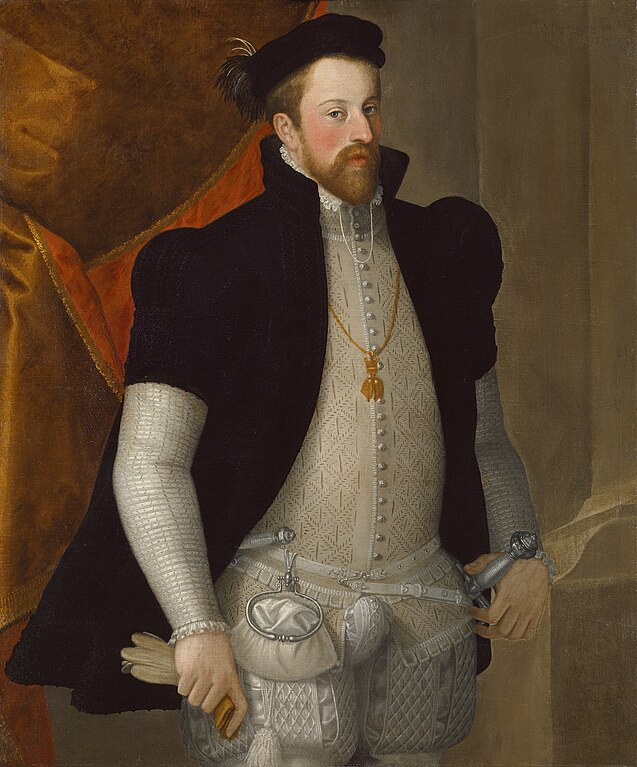 |
Ferdinand II of Austria |
(1529-1595)
Archduke of Austria, Imperial Prince 1556, Royal Prince of Hungary, Royal Prince of Bohemia, Count of Tirol, Governor of Bohemia 1547-1563
Regent of Bohemia 1564, Ruler of Tyrol & Austrian Forelands 1564-1595.
Husband of:
1. Philippine Welser (1527-1580), Baroness of Zinnenburg, Margravine of Burgau, Landgravine of Mellenburg, Countess of Oberhohenberg, Countess of Hiederhohenberg, mar 1557
Daughter of: Franz Anton Welser, Baron of Zinnenburg, patrician from Augsburg & Ann Adler.
 |
| Philippine Welser |
A 16th century love story.
"The castle [Ambras Castle] was extensively remodeled by Ferdinand II (1529-1595) in the mid 16th century as a love nest for his bride, Philippine Welser (1527 to 1580). . . Ferdinand . . . assisted his father in keeping law and order in the imperial lands. He was made Governor of Bohemia in 1547 and led the campaign against the Turks in Hungary in 1556. Somewhere along the way, he was introduced to Philippine reputedly by her aunt, Katharina von Loxan. Philippines was by all accounts beautiful, highly intelligent and had a very kind heart. However, as the daughter of an Augsburg merchant and financier, she was not considered to be of noble enough rant to marry the likes of Ferdinand. Undaunted, Ferdinand defied his father's will and secretly married Philippine in 1557. His father was not best pleased and Ferdinand was apparently despatched off to rule over the Tyrol. . . Ferdinand moved himself and his wife out to Ambras and he lived here from 1563 to 1585 (staying on after Philippine's death in 1580). . . ." (Le Chic en Rose)
"During his years in Prague Ferdinand entered into a liaison with Philippine Welser (1527-1580), the daughter of a wealthy Augsburg patrician, eventually marrying her in 1557. This morganatic union was initially kept secret from his father. Not until 1559 did Ferdinand inform his father about the marriage, which he had contracted without the latter's permission. At first he had to swear under oath to keep the marriage secret. Philippine thus officially lived together with her husband as his concubine. In 1576 Ferdinand was released from his oath by the Pope and was then able to recognize his wife officially. The union produced two sons, Andreas and Karl, who were not counted as members of the Habsburg dynasty. Until the official announcement of their parents' marriage they (together with two siblings who had died in infancy) were officially regarded as foundlings who had been taken into the archduke's household 'out of charity'." (The World of the Habsburgs)
"During his years in Prague Ferdinand entered into a liaison with Philippine Welser (1527-1580), the daughter of a wealthy Augsburg patrician, eventually marrying her in 1557. This morganatic union was initially kept secret from his father. Not until 1559 did Ferdinand inform his father about the marriage, which he had contracted without the latter's permission. At first he had to swear under oath to keep the marriage secret. Philippine thus officially lived together with her husband as his concubine. In 1576 Ferdinand was released from his oath by the Pope and was then able to recognize his wife officially. The union produced two sons, Andreas and Karl, who were not counted as members of the Habsburg dynasty. Until the official announcement of their parents' marriage they (together with two siblings who had died in infancy) were officially regarded as foundlings who had been taken into the archduke's household 'out of charity'." (The World of the Habsburgs)
Philippine's physical appearance & personal qualities.
" . . . It is clear, not only from the single authentic portrait which is extant, but also from all contemporary evidence, that Philippine must have his own heart-bee been wonderfully beautiful. She seems to have possessed extraordinary strength combined with the appearance of singular delicacy. It is recorded of her that she could not only handle her needle with supreme skill to embroider the Dank or prize for the victor in a tournament; she could also bend a tough steel cross-bow and send its bolt unerringly into the bull's eye of the target. She was far above the average height, but delicately and gracefully made. Her was was classic in outline, pale and full of nobility. The small and perfect mouth betrayed the loving, gentle disposition, in which Ferdinand found a ready response to his heart-beatings; the high curved nostrils promised that unswerving courage of which the young girl gave such abundant proof during the nine long years of waiting which preceded her marriage, and finally, the clear-cut, well-balanced chin and jaw gave evidence of that keen wisdom and wise judgment for which she was afterwards remarkable in the management of her household affairs. This exquisite head was poised upon a throat so swan-like as to make men say and repeat even to our own times that when she drank red wine the ruby colour of the juice could be seen trough the snowy whiteness of the outer skin." (The English Illustrated Magazine, Volume 7: 842)
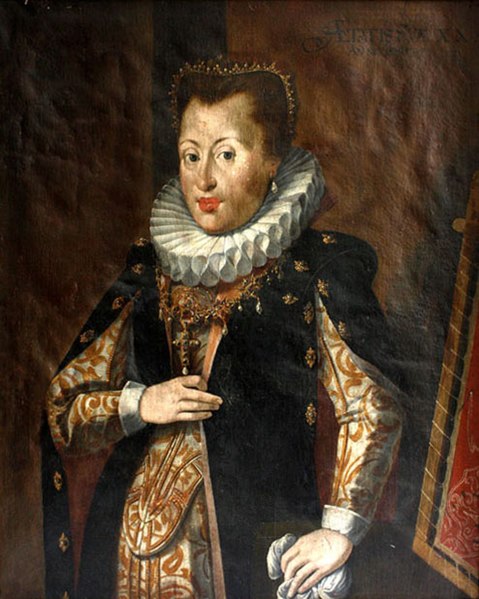 |
| Anna Caterina Gonzaga di Mantova |
2. Anna Caterina Gonzaga di Mantova. (1566-1621), mar 1582.
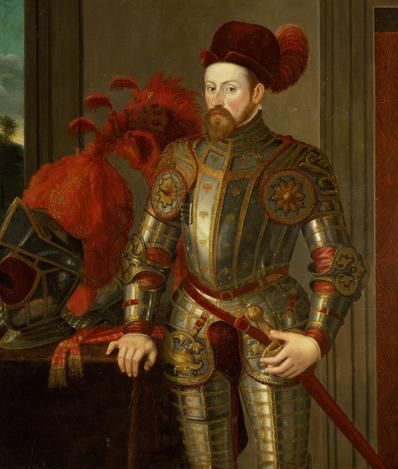 |
| Ferdinand II von Osterreich |
His lovers were:
1) Anna von Obrizon.
Natural offspring: Veronika von Villanders (1551-1589) mar Giovanni Francesco di Gonzaga.
2) Johanna Lydl von Mayenburg. (c.1530-?)
1) Anna von Obrizon.
Natural offspring: Veronika von Villanders (1551-1589) mar Giovanni Francesco di Gonzaga.
2) Johanna Lydl von Mayenburg. (c.1530-?)
Natural offspring:
a. Johannes Christoph von Hertenberg (1592-?), mar Ursula Gienger.
2) Unnamed mistress.
Ferdinand II von Osterreich Gallery.
2) Unnamed mistress.
Ferdinand II von Osterreich Gallery.
 |
| Philippine Welser, 1527 @ Ambras Castle |
"Ambras Castle is high on a hill above Innsbruck. This Renaissance castle built by Archduke Ferdinand II for the woman he secretly married, Philippine Welser, is filled with art and armor, curiosities, rare and precious items, and Habsburg portraits. Archduke Ferdinand II kept illustrated catalogues of his rare tournament armor, ornamental armor of famous military commanders, and his own armor and that of his court. Some of his collection goes back to the 15th century and the collections of Maximilian. Another belonged to court's giant Barlma Bon, who was in a tournament in Vienna in 1560." (Notable Travels)
 |
Ferdinand Karl of Austria |
(1868-1915)
Major-General of Austrian Army
His lover was:
Berta Czuber (1879-1979), mar 1909
Lover in 1902
"In 1902, Archduke Ferdinand Karl, a brother of the heir to the throne Franz Ferdinand, made the acquaintance of Bertha Czuber, the daughter of a Vienna university professor. He requested Franz Joseph’s permission to marry Bertha, but the Emperor refused. Nevertheless, Ferdinand continued to live quietly with his partner and in 1909 the two married secretly in Switzerland. In so doing, Ferdinand committed a clear violation of the Family Statute, which specified the necessity of obtaining the permission of the Emperor for a marriage of this kind. Ferdinand succeeded in keeping the marriage secret for two years. Finally, however, he informed Franz Joseph of the state of affairs and asked him to recognize the marriage, announcing that if recognition was not granted, he would leave the family: ‘In the event of Your Majesty not giving his most gracious consent to my request, I would naturally be compelled to renounce my title and other things, and to continue my life under some other name, e.g., Burg.’" (Secret Marriage in Switzerland @habsburger.net)
"Ferdinand Karl, the archduke's youngest brother, had also disappeared from public view. A quiet, genial man, devoted to literature, art, and science, he, too, had been estranged from Franz Ferdinand over his marriage and pointedly avoided him until he stumbled into his own romantic misadventure. Soon after snubbing the wedding in Reichstadt Ferdinand Karl fell in love with Bertha Czuber, daughter of a Viennese professor. She was intelligent, elegant, and beautiful, but Ferdinand Karl's confession that he meant to marry her had stunned his older brother; Sophie had been unequal, but at least she had been an aristocrat. He fared no better with the emperor. Having allowed the extraordinary union between his heir, Franz Ferdinand, and Sophie, Franz Josef was not about to sanction the morganatic marriage of a minor archduke with no such position to wield in favor of his arguments." (The Assassination of the Archduke)
Genealogical assassination into a non-person.
"As for Otto's younger brother, Ferdinand, his physical passions had ended by sweeping him off the family tree altogether. Nothing could dissuade him from marrying one Berta Czuber, the daughter of a Viennese university professor. For the Emperor a marriage between an Archduke and a mere Fraulein was not just unthinkable, it was unseeable. Ferdinand and his bride had to be driven out of sight. After stripping him successively of title, military rank and income, Franz Josef finally destroyed his youngest nephew's identity. In 1912 his name was erased from the tables of the imperial house and be became a Habsburg 'non-person'. Needless to add, this genealogical assassination had driven him from Vienna -- as was its intention. After years of wandering with his beloved 'Milly', Ferdinand died in 1915, aged forty-seven, and was buried in Munich as 'Her Burg'. To the end he had clung to one half of that great name." (Uncrowned Emperor: 15)
 |
| Leopold Ferdinand of Habsburg-Lorraine |
(1868-1935)
Principe di Toscana
 |
| Wilhelmine Adamowics |
His lover was:
Wilhelmine Adamowics.
". . . Leopold Ferdinand decided to marry somebody even less suitable. Wilhelmine Adamovicz, a daughter of a post office clerk and a prostitute he met in Wien in a part where she definitely wasn't only taking a stroll. Hearing that the naughty boy was up to, the Emperor had him relocated to Przemysl in Galizien. . . but was unaware that Leopold was not ready to give up his fight for Wilhelmine. He took her simply with him and had installed in his house as a housekeeper. Upon hearing this the Emperor chose not to grant him any clemency and had him re-located again. This time to an asylum in Koblenz." (Kreuzberged)
"His interest in pretty girls was clearly not a one-off matter and even extended to his marrying a dancing girl 10 years after the 1893 voyage. Actually it seems that 'dancing girl;' may have been a euphemism for prostitute, but, to give Leopold his due, he turned down an offer from his parents of 100,000 florins to leave her and decided to renounce his crown instead. He was obliged to leave Austria and became a Swiss citizen - no doubt welcomed by the gnomes as a result of a 200,000 crowns settlement and an annual income of 20,000 crowns from his parents. He took the name of Leopold Wolfling - from a mountain." (Ship Histories)
"And so on January 27th, 1903, Leopold Wolfling and Wilhelmine married. Since part of the deal with the Kaiser was never returning to Austria again, they lived first in Genf and Zug and afterwards moved to a colony of The People of Nature, set up by another high-society drop-out, Lieutenant Karl Groser in Ascona. There they ate fruit, wandered about wearing linen robes and tried to become one with the world. After only a couple of weeks Herr Wolfling had enough of spiritual excursions and meat-free diet and moved on. Alone. The divorce would be trough only a couple of years later, in 1907. Wilhelmine will be dead less than a year later." (Kreuzberged)
The Archduke in Brief: ". . . Herr Wolfling is the eldest son of the late Grand Duke of Tuscany Ferdinand IV, cousin of the ill-fated Emperor Franz Joseph. From his earliest years he was an intelligent, headstrong, romantic boy; the stuffy etiquette of the Austrian Court could not tame him; he fell in love with a beautiful girl but was not permitted to marry her; he was expelled from the Navy and Army; he was disinherited; he has been twice married and twice divorced; he has been shut up in a lunatic asylum; has starved; sold sausages for a living; and now, at the age of sixty-two he is living on the outskirts of Vienna with his adopted daughter and her husband, a taxi-driver. . . ." (Spectator)
 |
| Otto Franz of Austria |
"Archduke Otto was an extremely handsome young man; tall and dark with the glowing black eyes of his Italian mother, a princess of Parma. While I was only impressed by his good looks, Father was deeply moved to find himself in the presence of the descendant of Emperor Francis Joseph, under whose reign he had spent his youth." (Beyond the Chestnut Trees: A Memoir)
A handsome & charming but most debauched prince.
"There was good reason for his delight. Throughout that enormous reign of his, he had seen almost nothing in the house of Habsburg but marriages which were disastrous or disenchanted. There were two salutary examples in the bridegroom's own family. His father, Otto, as handsome and charming a man as any in Viennese society, had also turned into one of most debauched. He soon drifted away from his plain and placid bride, Princess Maria Josefa of Saxony, and slid into a vortex of self-indulgence which dragged him down to an early death when aged barely forty in 1906. The Monarchy was thus spared him as a future sovereign, just as the British Empire had had its lucky escape when the odious and perverted Duke of Clarence met his death in 1892 at the even earlier age of twenty-eight." (Uncrowned Emperor: The Life and Times of Otto von Habsburg: 15)
An incurable roue by night.
A handsome & charming but most debauched prince.
" . . . His [Emperor Karl] father, Otto, as handsome and charming a man as any in Viennese society, had also turned into one of most debauched. He soon drifted away from his plain and placid bride, Princess Maria Josefa of Saxony, and slid into a vortex of self-indulgence which dragged him down to an early death when aged barely forty in 1906. The Monarchy was thus spared him as a future sovereign, just as the British Empire had had its lucky escape when the odious and perverted Duke of Clarence met his death in 1892 at the even earlier age of twenty-eight." (Uncrowned Emperor: The Life and Times of Otto von Habsburg: 15)
A most scandal-ridden royal.
"Archduke Otto, called Bolla, is regarded as one of the most scandal-ridden members of the Habsburg dynasty. And yet his life began in the classic fashion for a Habsburg. Otto came from a devoutly Catholic family and embarked on a career in the army, as was the convention for later-born sons of the dynasty.
"There was good reason for his delight. Throughout that enormous reign of his, he had seen almost nothing in the house of Habsburg but marriages which were disastrous or disenchanted. There were two salutary examples in the bridegroom's own family. His father, Otto, as handsome and charming a man as any in Viennese society, had also turned into one of most debauched. He soon drifted away from his plain and placid bride, Princess Maria Josefa of Saxony, and slid into a vortex of self-indulgence which dragged him down to an early death when aged barely forty in 1906. The Monarchy was thus spared him as a future sovereign, just as the British Empire had had its lucky escape when the odious and perverted Duke of Clarence met his death in 1892 at the even earlier age of twenty-eight." (Uncrowned Emperor: The Life and Times of Otto von Habsburg: 15)
An incurable roue by night.
"Another flamboyant figure---and a favorite target of scandalmongers---was the emperor's nephew, Archduke Otto (1865-1906). This younger brother of Franz Ferdinand had married Maria Josepha, a prim daughter of the king of Saxony, and it was their son Karl (1887-1922) who ruled as Emperor Karl I. Torn between his father's punctilio and his mother's Neapolitan blood, by day Otto was the most fastidious of officers and by night an incurable roue. On one occasion when he and his riding companions glimpsed a funeral cortege across a meadow, they proceeded to jump their horses over the hearse. His most famous prank was to appear before ladies in the lobby of the Hotel Sacher, stark naked except for his officer's sword and cap. . . Disregarding his own affair with an actress, in 1900 Otto deplored Franz Ferdinand's morganatic marriage. When Otto died, the press waxed fulsom in praise of an archduke whom everyone knew to have been a wastrel." (The Austrian Mind: An Intellectual and Social History, 1848-1938: 41)
A von vivant with numerous extramarital affairs.
"Otto is described as being good-natured and affectionate, in contrast to his dour, withdrawn elder brother Franz Ferdinand, who remained jealous of the younger boy all his life. Gifted, amiable and fun-loving, Otto grew up to become a very good-looking young man. Otto’s numerous extramarital affairs and dissolute lifestyle resulted in scandals which caused outrage both in public life and within the imperial family itself. Otto was a bon vivant who had numerous extramarital affairs. Besides the children born in wedlock he also had a number of illegitimate offspring, some of whom he recognized officially, thus ensuring that they were provided for. He had a son with the ballet dancer Marie Schleinzer and a daughter from his long-term liaison with the singer Louise Robinson." (The World of the Habsburg)
A von vivant with numerous extramarital affairs.
"Otto is described as being good-natured and affectionate, in contrast to his dour, withdrawn elder brother Franz Ferdinand, who remained jealous of the younger boy all his life. Gifted, amiable and fun-loving, Otto grew up to become a very good-looking young man. Otto’s numerous extramarital affairs and dissolute lifestyle resulted in scandals which caused outrage both in public life and within the imperial family itself. Otto was a bon vivant who had numerous extramarital affairs. Besides the children born in wedlock he also had a number of illegitimate offspring, some of whom he recognized officially, thus ensuring that they were provided for. He had a son with the ballet dancer Marie Schleinzer and a daughter from his long-term liaison with the singer Louise Robinson." (The World of the Habsburg)
Death by syphilis.
"Karl was a young man of nineteen when his father, Franz Ferdinand's handsome and promiscuous younger brother, succumbed to syphilis at the age of forty-one. An unending tidal wave of speculative nonsense has accused so many royal and political figures of suffering from syphilis that it would be easy to dismiss all such stories as scurrilous idiocy based on the laws of probability, however every now and then, as in the case of Karl I's father, the rumour was true and undeniable, particularly in an era when there was no possibility of hiding the disease's devastating progression. Initially, stories of the 'gorgeous Archduke' and his many lovers seemed to amuse rather than horrify, such as the story in which he was caught one evening preparing to enter a young lady's bedroom wearing nother but his ornamental sword and a big smile. In the end, however, his bed-hopping became so compulsive that even his uncle the Enperor, who was very fond of him and defended 'handsome Otto' at every turn, began to distance himself. His wife, Maria Josepha of Saxony, tried shield their children from their father' terrible example and she largely succeeded. Otto contracted the disease sometime around 1900, by which point he and Maria Josepha were essentially leading separate lives. He died in 1906 and the final few years of the disease had been excruciating as well as disfiguring, forcing him to retire almost completely from public life." (The Emperors: How Europe's Rulers Were Destroyed by the First World War)
"A life of debauchery had not been kind to handsome Otto. His marriage to Maria Josepha produced two sons, but everyone knew it was a farce, and the archduke was quickly back to his drunken nights, mistresses, and fathering illegitimate children with a ballerina. Maria Josepha endured it all, at least until the night her husband led his drunken friends to her bedroom and laughed at how hideously unappealing he really found his wife. Otto was ordered to live elsewhere, though imperial decorum dictated that the couple appear together at court and pretend that nothing was wrong." (The Assassination of the Archduke)
"Franz Ferdinand needed to look no further than his younger brother Otto to see the tragic end of court-arranged marriages. Once considered the handsomest Habsburg of them all, his public and private debauchery resulted in a slow, painful, syphilitic death. After deserting the wife he loathed---his nose, larynx, and reputation gone---only his mistress, confessor, and his loyal stepmother remained at his side when died." (Hitler and the Habsburgs: The Führer's Vendetta Against the Austrian Royals)
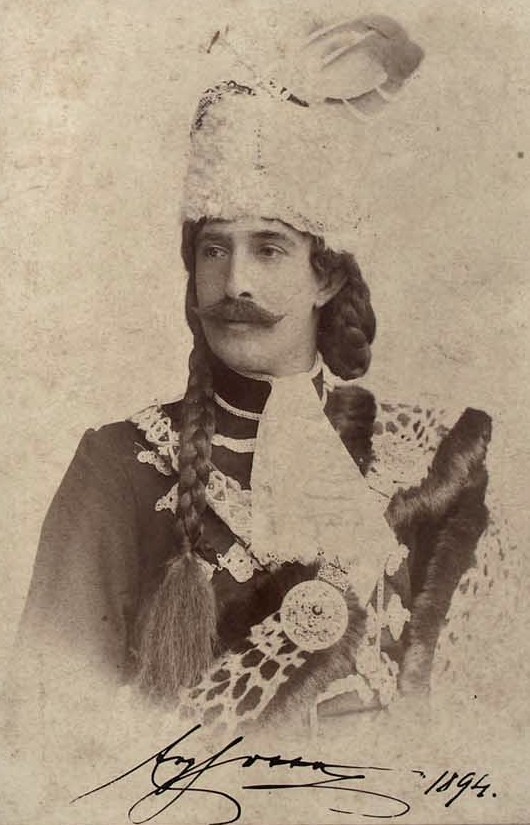 |
Otto Franz of Austria |
Otto Franz's lovers were:
1) Louise Robinson (d.1934)
Austrian actress
Wife of: Baron Poglodowski.
"Archduke Otto had two illegitimate children by Louise Robinson, an actress who married a Baron Poglodowski (she died destitute in a Vienna hospital, probably on 11‑12‑1934.). 'No secret was made about the liaison and she frequently lived in his palace ... there were two children by the union.' according to the NYTimes article, the son became an electrician and the daughter a governess in Wiesbaden. 'Some years ago both emigrated to America. They settled in Pennsylvania'." (Angelfire)
 |
| Marie Schleinzer |
2) Marie Schleinzer (1874-1949)
Austrian ballerina
Austrian ballerina
Wife of Dr. Julius von Hortenau.
Natural Offspring:
1. Alfred Joseph von Hortenau (1892-1957)
2. Hildegard von Hortenau (1894-?).
1. Alfred Joseph von Hortenau (1892-1957)
2. Hildegard von Hortenau (1894-?).
 |
| Wilhelm of Austria |
(1895-1948)

His lovers were:
1) Constant Kroll.
" . . . The other was Wilhelm's valet, a Latvian called Constant Kroll, who served in Wilhelm's Enghien household from 1926 to 1928. As the French police put matters, more or less tactfully, Wilhelm exhibited toward Kroll a 'sympathy that left no doubt about the nature of their relationship.' When Wilhelm traveled to Spain, his first concern was that his hotel room communicated directly with the room next door, and that both rooms have a bath. This was for convenient access to his male secretary. He brought a man with him when he traveled, either Larischenko or Kroll, and perhaps both." (Snyder, 2010, p. 163)
2) Eduard Larischenko.
" . . . He remained especially close to Eduard Larischenko, his personal secretary since 1918. Larischenko had been involved with the Ukrainian syndicate in Vienna, and then with Wilhelm's Madrid business. He was one of the two important men in Wilhelm's life...." (Snyder, 2010, p. 163)
3) Paulette Couyba.
"...Paulette and Wilhelm had found each other somewhere in Paris in the early 1930s, perhaps in the Montmartre demimonde where Wilhelm was going down while Paulette was coming up. She was a fraud, a bounder, a lover, something of a genius...." (Snyder: 158)
"Wilhelm then took up an aimless life in Paris and became part of the demimonde of expatriate aristocrats, homosexuals and adventurers. From relatives, including the exiled King Alfonso XIII of Spain (a notably expert golf, tennis and polo player), came periodic subventions that paid Wilhelm's personal expenses. Wilhelm too up with one Paulette Couyba, who involved him, seemingly without his knowledge, in a carefully planned financial fraud. An investigation implicated Wilhelm and he fled the country.
"In August, Wilhelm may have feared his time was coming to an end, and secretly headed for the Sudbahnhof, perhaps to flee Vienna, but was seized by Soviet soldiers, imprisoned and interrogated. A year later he died in captivity of tuberculosis. He was too old, in any event, to have lived to see today’s Orange Revolution in Ukraine." (Washington Times)
Paulette Couyba's other lovers:
1) Anatole de Monzie.
French politician
" . . . She was believed to be the secretary and lover of Anatole de Monzie, a left-wing politician, friend of the Soviet Union, and minister of education in the early 1930s. . . ." (Snyder: 159)
2) Joseph Caillaux.
2) Joseph Caillaux.
French politician
3) Maurice de Rothschild.
3) Maurice de Rothschild.
" . . . She was also thought to be the assistant and lover of Maurice de Rothschild, a prominent member of the French branch of that extraordinary wealthy family." (Snyder: 159)
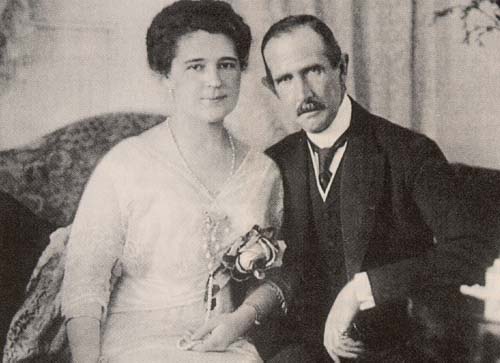



No comments:
Post a Comment